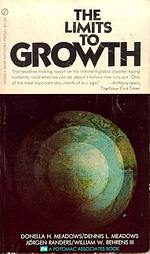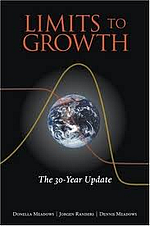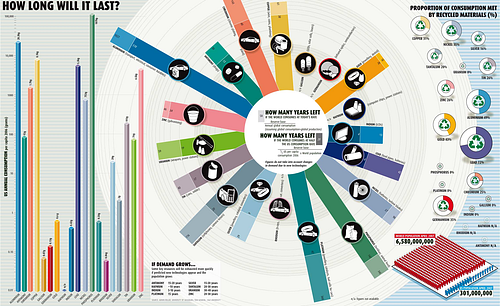3b.
Limits to Growth – How long will the World’s natural resources last?
1968, after the awakening of environmental awareness in the 1960s, the Club of Rome, a Club of 100 influential individuals in science, politics and business, formed. The members were concerned about world future development. They asked themselves: “How long can we go on using increasing amounts of natural resources, without harming our societies?” The challenge to study the long term future and resource use was given to a research team at Massachusetts Institute of Technology, MIT, in Cambridge, USA led by two young scientists Donella and Dennis Meadows.
The team’s basic assumption was that all the different important trends in world development were inter-dependent and thus made up a huge system. This system was simulated, using a computer tool called systems dynamics, in a model called World 3. Enormous amounts of statistical information was collected and summarized in 5 main parameters: resource flow, environmental impact, industrial production, human population and food production.

 The result was published in 1972 in a small book called Limits to Growth. It showed that if no changes were made (=business as usual) all the parameters discussed would grow up to a point, when after a peak they would turn down. After that point we should expect a world with shrinking resources, less production, increased pollution, diminishing population etc. The model timeline were 200 years (1800-2100). The peak was, according to the model, to happen about 2050.
The result was published in 1972 in a small book called Limits to Growth. It showed that if no changes were made (=business as usual) all the parameters discussed would grow up to a point, when after a peak they would turn down. After that point we should expect a world with shrinking resources, less production, increased pollution, diminishing population etc. The model timeline were 200 years (1800-2100). The peak was, according to the model, to happen about 2050.
The Limits to Growth study became a key issue of discussion during the following years. It was translated into about 35 languages. Economists in general were critical; the developing world was critical. Environmental scientists saw it as a fundamental study and an important platform of the growing sustainability science. In 2004 the research team published a 30-year follow-up. Amazingly all the statistics, now with much improved data, and an additional number of parameters, confirmed the old conclusions, with the addition that the time for peak had come closer in time – about 2025 – as the resource flow had accelerated more than predicted. Now also economists agreed that the conclusion were valid. There are limits to growth!
One should not be surprised by the message that overuses of resources leads to an overshoot, followed by a peak and collapse. We have seen it many times in ecosystems, when populations of rodents or other animals collapsed because they overused the resource they lived on. Normally there is negative feedback, such as a carnivore hunting the population, but if this is missing there will be overshoot and collapse. Humanity does not have such negative feedback. We have to understand and restrict resource use ourselves. This alternative, to live in balance with the resources, is called dynamic equilibrium.
The Limits to Growth authors stressed that the predicted overshoot and collapsed was only to happen if nothing was done to change business as usual. They also stressed that it was not enough with more efficient resource use (decoupling) or relying on new technologies; changes in lifestyles would be necessary to change the path in a more sustainable direction.
During the 1990s, other research teams started to work on a similar theme. One was Canadian human ecologist William Rees and Swiss-born Mathis Wackernagel. They summarized how many resources every one of us uses (energy, food, timber etc, etc) recalculated into a biologically active surface on the planet called the ecological footprint, measured in global hectares (gha) and using a life cycle approach. In the world as a whole, there is about 1.8 ha per capita (2006 population). This is the carrying capacity of our planet. But some countries are using much more than that, e.g. Sweden about 6 and Poland about 4,5 ha/capita, while others, like Indian, use less.
Over the entire world, the footprint is about 2.7 ha/capita. We are in an overshoot since about 1980. This is manifested into the date when the resources of the planet produced that year are used up, called Earth Overshoot Day. In 2012 the Earth Overshoot Day was according to Global Footprint Network August 22nd. These calculations are not very exact, but it is not the most important. It is also expressed as the number of planets needed to support humanity if everyone lived according to some chosen group. Globally we use about 1.3 planets. If everyone lived like they do in the USA – the most resource using nation in the world – we would need close to 6 planets. If everyone lived like we do in the Baltic Sea region, it is almost 3 planets. WWF started the project One Planet Living describing what to do to reduce resource consumption to the level of one planet (1.8 ha) if everyone did the same.
 Most people get worried about how much energy reserves we have left, but as this graphic shows, that's the least of our problems. The real problem is the materials we use to make things. (click to enlarge)
Most people get worried about how much energy reserves we have left, but as this graphic shows, that's the least of our problems. The real problem is the materials we use to make things. (click to enlarge)
A more detailed study of a number of global parameters was done in the Planetary Boundaries project, undertaken by the Stockholm Resilience Centre. There the task was to define what are the safe space within which humanity must stay for a number of environmental and resource flows parameters. Nine such parameters were studied. They included nitrogen, phosphorus and carbon flows, ozone layer, climate change, ocean acidification, biodiversity etc. The authors concluded that we are within safe limits for some of them such as ozone layer protection, but outside for others, e.g. biodiversity, nitrogen flows and carbon dioxide emission.
They concluded that humanity is today a force, which dominate the planetary development, earlier only possible for geological forces. We have entered a new geological era, which they call the Anthropocene.
Materials for session 3b
Basic level
- Read Environmental Science, chapter 25, pages 769-770: The Prospect of Sustainable Development
Environmental Science, chapter 25: The Prospect of Sustainable Development (in Russian). - Earth Overshoot Day by Global Footprint Network.
- The Basics of Ecological Footprint. Calculate your own footprint!
- Read about The Club of Rom.
- Watch Limits to growth 40 years later lecture by Dennis Meadows (YouTube film).
Medium level (widening)
- The Planetary Boundaries article in Nature 2009.
- Get to know the One Planet Living project and find out how you may change your own lifestyle.
-
What was the real message in Limits to Growth?
Advanced level (deepening)
- The detailed Planetary Boundaries report Stockholm Resilience Centre.
Additional material
Dennis Meadows – Perspectives on the Limits of Growth: It is too late for sustainable development (YouTube film). A talk on the 40-year celebration of the publication of the Limits to Growth on March 1st 2012 at the Smithsonian Institution, Washington DC.
References
Meadows, D. H., Randers, J. and D. L. Meadows. 1972. Limits to Growth – How long will the World’s natural resources last? Signet.
Meadows, D. H., Randers, J. and D. L. Meadows. 2004. Limits to Growth: The 30-Year Update. Chelsea Green.
Rockström, J. et al. 2009. Planetary Boundaries: Exploring the Safe Operating Space for Humanity. Ecology and Society 14(2): 32.
Rydén, L., Migula, P. and M. Andersson (eds). 2003. Environmental Science – understanding, protecting and managing the environment in the Baltic Sea region. Baltic University Press. Uppsala, Sweden.
BUP Sustainable Development Course
